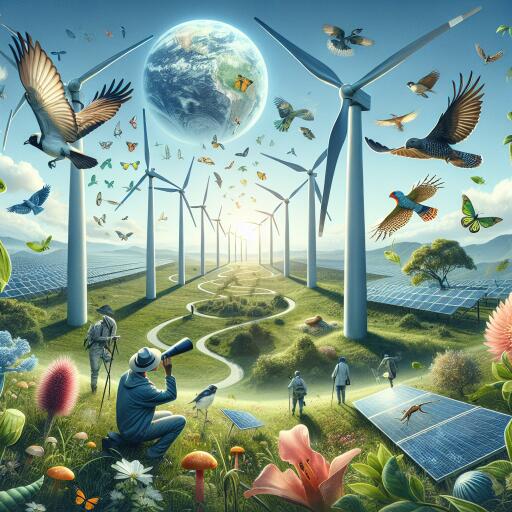
Clean energy and biodiversity engaging in a delicate balancing act * Earth.com
The quest for sustainable and clean energy sources is pushing humanity towards innovative solutions, as the urgency to address climate change intensifies. Yet, this push towards green energy intersects complexly with the necessity to maintain the planet’s rich biodiversity. A groundbreaking approach, originating from a study at the University of California, Davis, invites us to ponder this intersection, especially in terms of how renewable energy development impacts vital habitats for species at risk in the southwestern United States.
In an illuminating exploration into the future, the researchers combined renewable energy development maps with the habitats of significant species, including the climate-sensitive Joshua tree and the federally endangered San Joaquin kit fox. They uncovered striking projections: by 2070, Joshua trees could see a 31% reduction in habitat, while the San Joaquin kit fox could face an 81% decrease, all owing to climate change under a moderate emissions scenario. The calculations also included the impact of present and planned renewable energy projects, revealing an additional habitat loss of 1.7% for Joshua trees and 3.9% for kit foxes.
The dual challenges of promoting renewable energy usage for combating climate change and preserving biodiversity hotspots are at the core of the study’s message. The study suggests that expanding renewable energy is imperative, but it cautions against the potential overlap with biodiversity-rich areas that require protection.
The research emphasizes the potential of advanced computer modeling to find a harmony between biodiversity conservation and renewable energy site selection. It looks towards solutions that support species’ adaptation to changing environments while contributing to the green energy transition.
This investigation is set against a backdrop of rapidly increasing renewable energy development, with ambitions to significantly increase capacity to meet net zero emissions goals by 2050. This increase, however, must navigate the complexities of habitat preservation amidst significant biodiversity declines over the past decades, primarily from habitat loss and climate change effects.
The study also hints at the possibility that renewable energy projects could, with thoughtful planning, contribute positively to species conservation. For example, the San Joaquin kit fox has shown adaptability by using solar facilities for shelter, pointing towards the potential for renewable energy infrastructures to support certain wildlife species if designed with ecological sensitivity.
Looking to the future, the research team advocates for frameworks that guide clean energy developers in making informed site selection choices that consider anticipated animal range shifts due to climate change. The goal is to move towards solar and wind energy development that fulfills renewable energy objectives while also respecting biodiversity conservation and social equity.
The ambitious vision put forth by this study underscores the intricate balancing act required to advance renewable energy projects without compromising biodiversity. With thoughtful utilization of advanced computational tools and dynamic species mapping, there’s potential to chart a sustainable course that honors both our energy needs and our commitment to preserving the natural world.
The drive for clean energy is pressing, yet it’s crucial that our green initiatives do not undermine the delicate ecological balances sustaining the planet’s biodiversity. The integration of renewable energy projects into environments in a manner that’s harmonious with local ecosystems demands inventive strategies, careful planning, and a deep commitment to sustainability.
Comprehensive environmental impact assessments, early identification of sensitive habitats, and the use of technology to minimize ecological disturbances are all part of crafting a future where clean energy and biodiversity flourish. By navigating these challenges with foresight and dedication, we can ensure that our strides towards a cleaner future also bolster the planet’s biodiversity, creating a sustainable and just world for all.
As we continue on this journey, the collaborative efforts of developers, policymakers, and conservationists will be paramount. Together, through rigorous research, thoughtful planning, and a shared commitment to the environment, we can forge a path that truly balances the needs of our planet with those of its inhabitants. The pursuit of renewable energy, when aligned with biodiversity conservation, embodies our hope for a healthier, sustainable future.
Embrace this narrative of progress and sustainability by subscribing to our newsletter for more insightful articles, exclusive content, and the latest updates on our collective journey towards a greener, more biodiverse world.





Leave a Reply